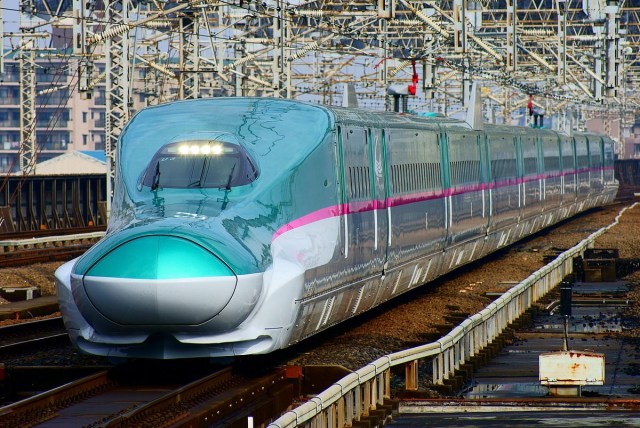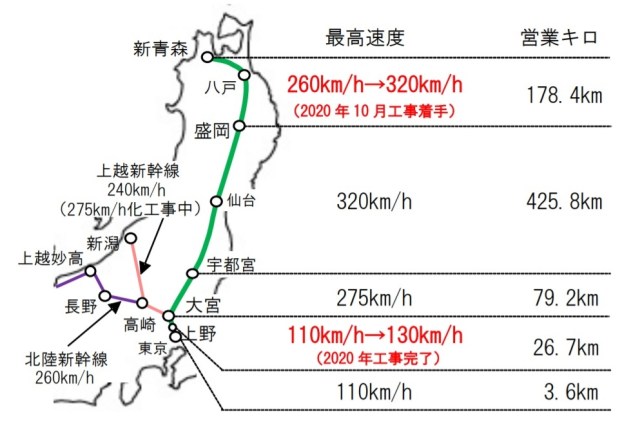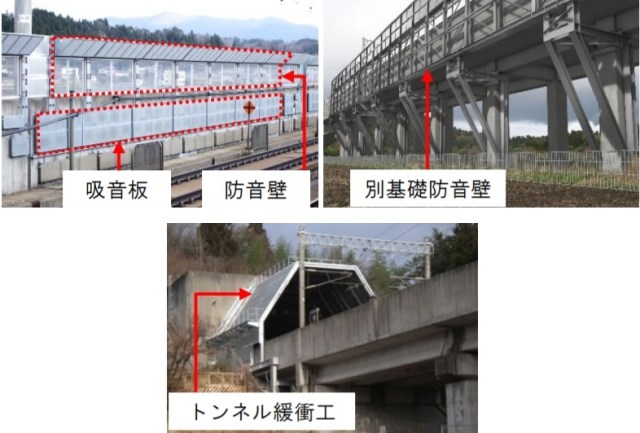
Good news if you want to get there even faster than a speeding bullet train can right now.
Japan’s Shinkansen are all fast, which is how they earned their English-language nickname “bullet trains.” But with no numerical limit on speed, there’s always the possibility of getting from point A to point B even more quickly, and that’s what East Japan Railways (a.k.a. JR East) wants to do with a newly announced upgrade to its Tohoku Shinkansen route, which runs from Tokyo to Aomori Prefecture, the northeastern tip of Japan’s main island of Hokkaido.
Shinkansen travel at different speeds depending on which section of the track they’re passing through, and JR East wants to boost that speed by 23 percent, raising it to 320 kilometers (198.8 miles) per hour from 260, for the section between Morioka Station, in Iwate Prefecture, and Shin Aomori Station, in Aomori Prefecture. This would cut the travel time between the two stations by 10 percent, shortening it to 43 minutes.
The change will extend the Tohoku Shinkansen’s 320-kilometer-per-hour section, which currently consists of only the area between Tochigi Prefecture’s Utsunomiya Station and Morioka, by an additional 178.4 kilometers, encompassing the entire line north of Utsunomiya.
▼ A map showing the planned new 320-kilometer-per-hour area, and also a shift from 110 kilometers per hour to 130 which is being implemented this month on the Shinkansen between Tokyo’s Ueno and Saitama Prefecture’s Omiya stations.
However, raising the Shinkansen’s speed isn’t as simple as just telling the conductor to open up the throttle. Along with safety upgrades to the track, JR East also has to beef up its sound-absorption infrastructure, since a 320-kilometer-an-hour train can make a lot of noise as it whistles by. Starting this month, the company will be installing additional sound-absorbing materials, raising the height of sound-blocking walls, and extending the buffering canopies on tunnels between Morioka and Shin-Aomori.
The entire project is expected to be finished in 2027.
Source: JR East via IT Media
Top image: Wikipedia/Nanashinodensyaku
Insert images: JR East
● Want to hear about SoraNews24’s latest articles as soon as they’re published? Follow us on Facebook and Twitter!



 All-you-can-ride Shinkansen deal coming to Japan for a limited time
All-you-can-ride Shinkansen deal coming to Japan for a limited time Here’s your chance to ride Japan’s maglev Shinkansen in spring, nine years before service starts
Here’s your chance to ride Japan’s maglev Shinkansen in spring, nine years before service starts Free Wi-Fi now available on Tohoku Shinkansen, inside Tokyo’s Yamanote Line stations
Free Wi-Fi now available on Tohoku Shinkansen, inside Tokyo’s Yamanote Line stations Japan’s West Kyushu Shinkansen bullet train service to Nagasaki is set to open this fall
Japan’s West Kyushu Shinkansen bullet train service to Nagasaki is set to open this fall Disney Shinkansen coming to Japan’s rails, starts service this month
Disney Shinkansen coming to Japan’s rails, starts service this month Foreigner’s request for help in Tokyo makes us sad for the state of society
Foreigner’s request for help in Tokyo makes us sad for the state of society Japanese city loses residents’ personal data, which was on paper being transported on a windy day
Japanese city loses residents’ personal data, which was on paper being transported on a windy day Akihabara pop-up shop sells goods made by Japanese prison inmates
Akihabara pop-up shop sells goods made by Japanese prison inmates Where to buy a Curry Bread Grand Prix 2023 award-winning karepan in Japan
Where to buy a Curry Bread Grand Prix 2023 award-winning karepan in Japan Red light district sushi restaurant in Tokyo shows us just how wrong we were about it
Red light district sushi restaurant in Tokyo shows us just how wrong we were about it Harajuku Station’s beautiful old wooden building is set to return, with a new complex around it
Harajuku Station’s beautiful old wooden building is set to return, with a new complex around it Anime girl English teacher Ellen-sensei becomes VTuber/VVTUber and NFT
Anime girl English teacher Ellen-sensei becomes VTuber/VVTUber and NFT Ghibli Park now selling “Grilled Frogs” from food cart in Valley of Witches
Ghibli Park now selling “Grilled Frogs” from food cart in Valley of Witches Pokémon Sleep camping suite and guestrooms coming to Tokyo Hyatt along with giant Snorlax burgers
Pokémon Sleep camping suite and guestrooms coming to Tokyo Hyatt along with giant Snorlax burgers Tokyo Tsukiji fish market site to be redeveloped with 50,000-seat stadium, hotel, shopping center
Tokyo Tsukiji fish market site to be redeveloped with 50,000-seat stadium, hotel, shopping center McDonald’s new Happy Meals offer up cute and practical Sanrio lifestyle goods
McDonald’s new Happy Meals offer up cute and practical Sanrio lifestyle goods Japanese ramen restaurants under pressure from new yen banknotes
Japanese ramen restaurants under pressure from new yen banknotes French Fries Bread in Tokyo’s Shibuya becomes a hit on social media
French Fries Bread in Tokyo’s Shibuya becomes a hit on social media Studio Ghibli releases new action figures featuring Nausicaä of the Valley of the Wind characters
Studio Ghibli releases new action figures featuring Nausicaä of the Valley of the Wind characters New private rooms on Tokaido Shinkansen change the way we travel from Tokyo to Kyoto
New private rooms on Tokaido Shinkansen change the way we travel from Tokyo to Kyoto All-you-can-drink Starbucks and amazing views part of Tokyo’s new 170 meter-high sky lounge
All-you-can-drink Starbucks and amazing views part of Tokyo’s new 170 meter-high sky lounge Beautiful Ghibli sealing wax kits let you create accessories and elegant letter decorations【Pics】
Beautiful Ghibli sealing wax kits let you create accessories and elegant letter decorations【Pics】 Studio Ghibli releases Kiki’s Delivery Service chocolate cake pouches in Japan
Studio Ghibli releases Kiki’s Delivery Service chocolate cake pouches in Japan New definition of “Japanese whiskey” goes into effect to prevent fakes from fooling overseas buyers
New definition of “Japanese whiskey” goes into effect to prevent fakes from fooling overseas buyers Our Japanese reporter visits Costco in the U.S., finds super American and very Japanese things
Our Japanese reporter visits Costco in the U.S., finds super American and very Japanese things Studio Ghibli unveils Mother’s Day gift set that captures the love in My Neighbour Totoro
Studio Ghibli unveils Mother’s Day gift set that captures the love in My Neighbour Totoro More foreign tourists than ever before in history visited Japan last month
More foreign tourists than ever before in history visited Japan last month New Pokémon cakes let you eat your way through Pikachu and all the Eevee evolutions
New Pokémon cakes let you eat your way through Pikachu and all the Eevee evolutions Sales of Japan’s most convenient train ticket/shopping payment cards suspended indefinitely
Sales of Japan’s most convenient train ticket/shopping payment cards suspended indefinitely Sold-out Studio Ghibli desktop humidifiers are back so Totoro can help you through the dry season
Sold-out Studio Ghibli desktop humidifiers are back so Totoro can help you through the dry season Japanese government to make first change to romanization spelling rules since the 1950s
Japanese government to make first change to romanization spelling rules since the 1950s Ghibli founders Toshio Suzuki and Hayao Miyazaki contribute to Japanese whisky Totoro label design
Ghibli founders Toshio Suzuki and Hayao Miyazaki contribute to Japanese whisky Totoro label design Doraemon found buried at sea as scene from 1993 anime becomes real life【Photos】
Doraemon found buried at sea as scene from 1993 anime becomes real life【Photos】 Tokyo’s most famous Starbucks is closed
Tokyo’s most famous Starbucks is closed One Piece characters’ nationalities revealed, but fans have mixed opinions
One Piece characters’ nationalities revealed, but fans have mixed opinions We asked a Uniqlo employee what four things we should buy and their suggestions didn’t disappoint
We asked a Uniqlo employee what four things we should buy and their suggestions didn’t disappoint Princesses, fruits, and blacksmiths: Study reveals the 30 most unusual family names in Japan
Princesses, fruits, and blacksmiths: Study reveals the 30 most unusual family names in Japan New ultra-stylish, extra-traditional Shinkansen has tatami floors, foot baths
New ultra-stylish, extra-traditional Shinkansen has tatami floors, foot baths Japan’s newest Shinkansen is world’s fastest gallery, packed with contemporary art inside and out
Japan’s newest Shinkansen is world’s fastest gallery, packed with contemporary art inside and out New JR Shinkansen-inclusive rail pass is a huge bargain, great way to help out a region in need
New JR Shinkansen-inclusive rail pass is a huge bargain, great way to help out a region in need Travel tip! Japan Railways to offer awesome new three-day unlimited pass for Tokyo and east Japan
Travel tip! Japan Railways to offer awesome new three-day unlimited pass for Tokyo and east Japan Shinkansen will require reservations for large suitcases, charge penalty fees for those without
Shinkansen will require reservations for large suitcases, charge penalty fees for those without New Japan rail pass gives you a week of free rides in a huge space to chase the cherry blossoms
New Japan rail pass gives you a week of free rides in a huge space to chase the cherry blossoms All Japan Railway Tokyo trains to finally get security cameras starting this summer
All Japan Railway Tokyo trains to finally get security cameras starting this summer Shinkansen driver disciplined for taking poop break while train was going 150 kilometers an hour
Shinkansen driver disciplined for taking poop break while train was going 150 kilometers an hour Tokyo airport’s new train line to make getting into, out of the city easier for JR pass holders
Tokyo airport’s new train line to make getting into, out of the city easier for JR pass holders Tokyo farewells Japan’s only double-decker Shinkansen with a special escalator at the station
Tokyo farewells Japan’s only double-decker Shinkansen with a special escalator at the station Shinkansen conductor caught playing GPS smartphone game on bullet train…for TEN years
Shinkansen conductor caught playing GPS smartphone game on bullet train…for TEN years Tokaido Shinkansen ending in-train food/drink sales for all non-first-class-passenger cars
Tokaido Shinkansen ending in-train food/drink sales for all non-first-class-passenger cars Nozomi Shinkansen bullet train abolishes low-priced unreserved tickets during peak travel seasons
Nozomi Shinkansen bullet train abolishes low-priced unreserved tickets during peak travel seasons Japan Railways offering ‘Shinkansen for Pets’, includes dog-friendly vacation packages
Japan Railways offering ‘Shinkansen for Pets’, includes dog-friendly vacation packages East Japan Railway abolishes skirts, ribbons in women’s uniforms to “eliminate gender difference”
East Japan Railway abolishes skirts, ribbons in women’s uniforms to “eliminate gender difference” Want to choose the name of Tokyo’s most important new station? Here’s your chance!
Want to choose the name of Tokyo’s most important new station? Here’s your chance!
Leave a Reply